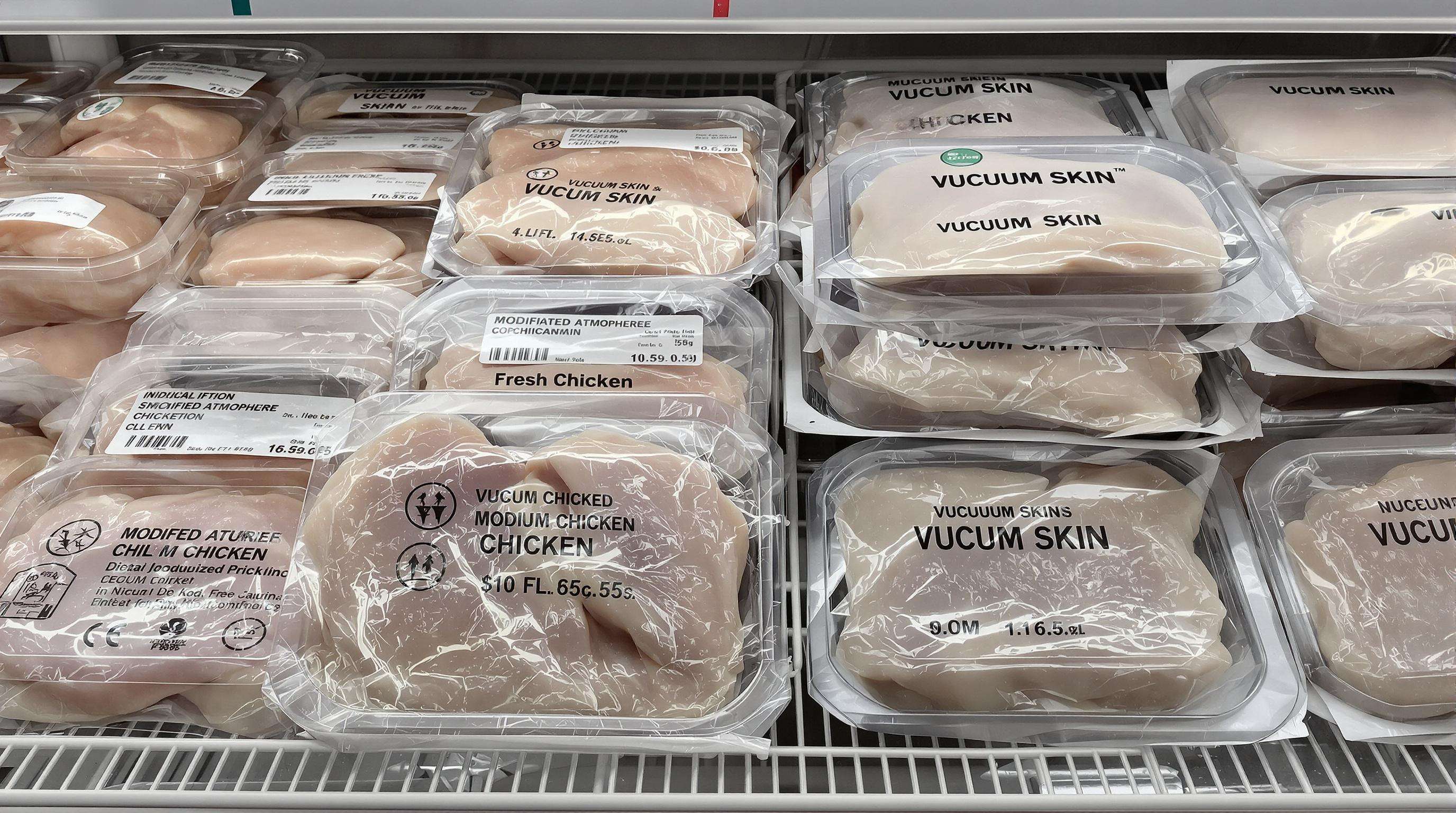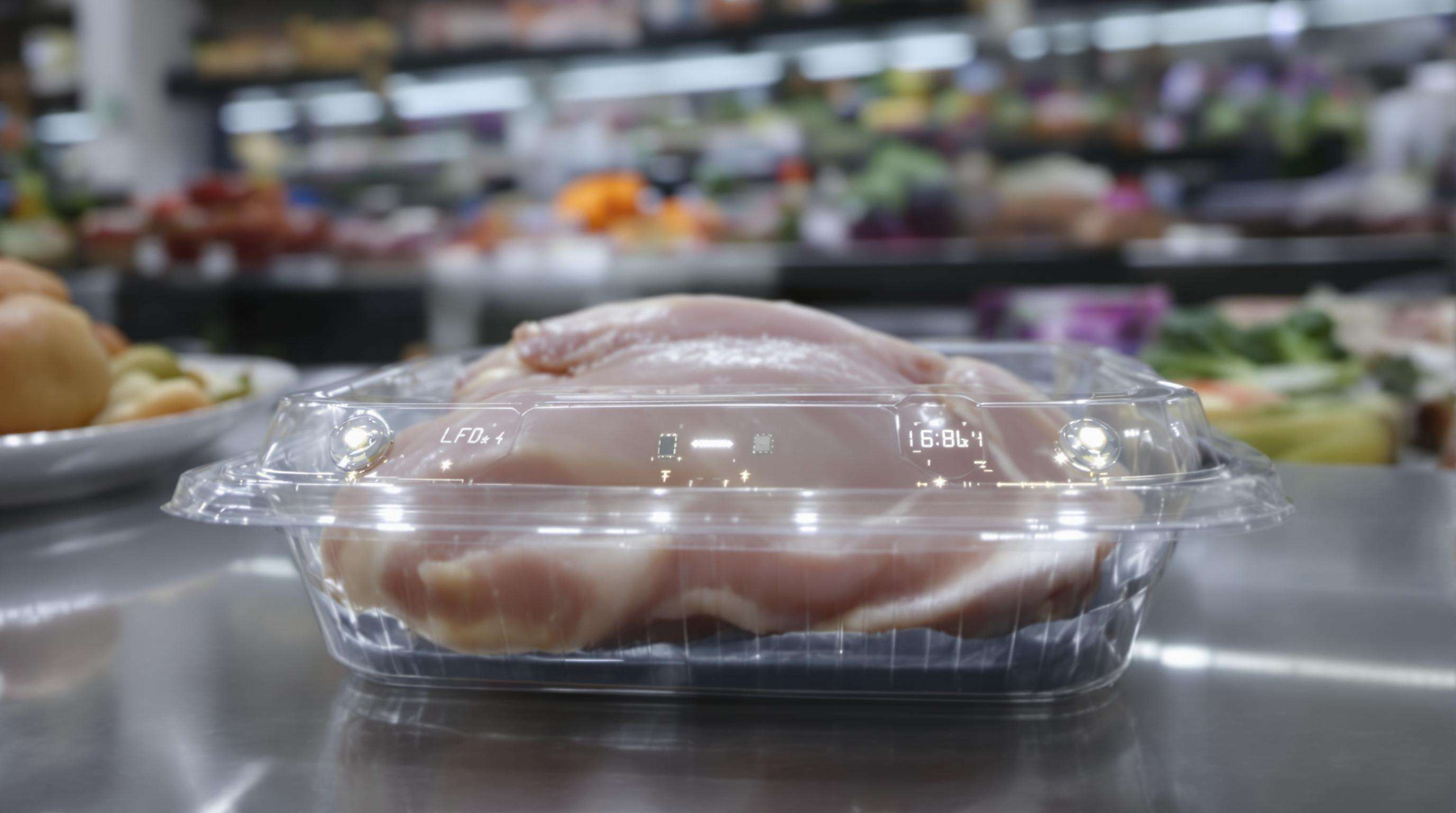Pažengusios pakuotės technologijos, kurios padeda užtikrinti vištienos saugą
Suprasti maisto saugos iššūkius Vištienos pakuotė
Vištiena ir kiti paukštienos gaminiai turi savų užteršimo problemų. Pagal 2023 m. duomenis, Amerikoje kasmet apie 1,35 mln. žmonių susirgo dėl užterštos paukštienos, kaip nurodo Centers for Disease Control (Kontrolės ir prevencijos centrai). Standartinės pakuotės metodai nebegali išlaikyti drėgmės, užkirsti kelią deguoniui patekti į pakuotę arba sustabdyti bakterijų plitimą tarp pakuočių judant per tiekimo grandinę. 2022 m. žurnale Food Protection Trends paskelbti tyrimai taip pat atskleidė kažką labai nerimą keliančio: net 25 proc. vištienos mėginių, paimtų iš parduotuvių, vis dar turėjo Campylobacter bakterijų net po standartinės pakuotės. Tai aiškiai rodo, kiek reikia efektyvesnių pakuotės sprendimų, kurie tikrai galėtų susidoroti su šiomis atkakliomis patogeninėmis medžiagomis.
Kaip inovacinė pakuotė neleidžia mikrobiniam užteršimui
Nauji materiatai, tokie kaip deguonies sugertuvai ir plazmos aktyvuotos paviršiai, pagal 2023 metais paskelbtus tyrimus žurnale Journal of Food Engineering, laboratorinėmis sąlygoms sumažino bakterijų augimą beveik 99,8%. Vakuumu užsandarintos kompozitų sluoksnis puikiai sustabdo salmonelės prasiskverbimą ir išlaiko optimalų drėgmės lygį maisto saugojimui. Šių inovacijų vertė yra ta, kad jos pašalina pagrindines maisto užteršimo priežastis, pagal JAV maisto ir vaistų administracijos (FDA) atšaukimo duomenis. Paviršiaus kontaktas sukelia apie 42% visų problemų, po jo seka temperatūros pokyčiai – apie 31%, o sandarumo pažeidimai – maždaug 27% visų atvejų.
Antimikrobinės pakuotės sprendimai padidintai saugai
Augalų pagrindu gaminamos bioaktyvios dangos, kuriose yra tokių junginių kaip timolis ir nizinas, pastaruoju metu parodė labai žadantį efektą. Pagal 2024 metais paskelbtus tarptautinio maisto mikrobiologijos žurnalo tyrimus, chitino pagrindu pagamintos plėvelės sugebėjo sumažinti Listeria monocytogenes apie tris dydžio eiles tik per tris dienas. Maisto pramonė taip pat ima kurti naujoves, derindama šiuos natūralius antimikrobus su specialiais pH indikatoriais, kurie keičia spalvą pradedant sugesti. Ši kombinacija sukuria tai, ką daugelis vadina kitos kartos apsaugos sistemomis, ir, ką įdomu, jos netgi viršija tai, ką USDA laiko minimaliais saugos standartais. Kai kurios įmonės teigia, kad jų produktai atitinka šiuos patobulintus reikalavimus, išlaikydami konkurencingas kainas lyginant su tradiciniais išsaugojimo metodais.
Modifikuota atmosfera ir vakuumo odos pakuotė maksimaliam šviežumui

Kaip modifikuotos atmosferos pakuotė (MAP) pailgina vištienos laikymo laiką
Modifikuotos atmosferos pakuotė (MAP) keičia deguonį optimaliomis dujų mišiniais - dažniausiai azotu ir anglies dioksidu - kad būtų slopinamas mikrobo augimas, išlaikoma mėsos spalva ir struktūra. Atsižvelgiant į 38% šviežios maisto konservavimo sistemų (Globenewswire, 2024), MAP leidžia išlaikyti vištieną 3–5 dienas ilgiau nei tradicinė pakuotė. Tikslus dujų mišinys:
- Slopinamas aerobinių bakterijų dauginimasis
- Lėtėja fermentinė degradacija
- Mažėja lipidų oksidacija
Vakuumo apsauginė pakuotė (VSP): Aukštesnė apsauga ir vizualinis patrauklumas
VSP sukuria beveik orui nepraleidžiančią antro sluoksnį aplink vištienos gabalus naudodamas specialias polimerines plėveles, kurios priglunda tiesiai prie mėsos. Dėl apvalkalo viduje esančio deguonies stokos vištiena nepraranda drėgmės paviršiuje ir neatsiranda nemalonių ledų kristalų, vadinamų šaldytuvo deginimu. VSP išsiskiria dėl savo skaidrumo, palyginti su įprastomis vakuuminėmis maišelėmis. Vartotojai gali aiškiai matyti, kas yra viduje, todėl prekės atrodo kur kas patraukliau parduotuvės lentynose. Pagal trečiųjų šalių atliktus tyrimus, naudojant šį pakuojimo metodą, lyginant su tuo, kurį dažniausiai naudoja įmonės šaldytai mėsai, skysčių išsiskyrimas sumažėja maždaug 70 procentų.
Palyginimas tarp MAP ir VSP: našumas, kaina ir sugedimo mažinimas
| Gamintojas | MAP privalumas | VSP privalumas |
|---|---|---|
| Mikrobo kontrolė | Tikslinio tipo bakterijų kontrolė | Visapusiškas deguonies šalinimas |
| Vartojimo laikotarpio pratęsimas | 4–7 dienų trukmė | 5–9 dienų trukmė |
| Gamybos kaina | Aukštesis dujų infrastruktūra | Mažesnės vienetinės medžiagos kainos |
Atvejo analizė: Komercinio prekių tinkamumo laiko pratęsimas naudojant MAP ir VSP
Vienas didelis paukštienos perdirbimo įmonė sujungė MAP dujų plovimo technologiją su VSP drėgmės blokavimo plėvelėmis lėktuvų maisto gamybai. Ši hibridinė metodika pasiekė:
- 40 % mažesnis paruošimo iki išvykimo laikas
- 63 % mažiau skundų dėl sausumo
- 28 % ilgesnis atšaldytos saugojimo galiojimo laikas
Šis sprendimas sumažino maisto atliekas 18 metrinių tonų per metus, tuo pačiu atitikdamas griežtas ES aviacijos saugos standartus.
Išmanioji pakuotė realaus laiko vištienos šviežumos stebėjimui

Įvadas į Išmanioji pakuotė paukštienos išsaugojime
Vištienos pakuotė toliau vystėsi nei senamadiškos galiojimo datos, kuriomis visi pripratome pasikliauti. Vietoj to, įmonės pradeda naudoti išmaniąją technologiją, kuri iš tikrųjų stebi, kaip ilgą laiką mėsa išlieka šviežia. Kokia problema su tradicinėmis datavimo etiketėmis? Pagal 2025 m. Pasaulio išteklių instituto skaičius, jos yra atsakingos už maždaug 161 milijardų JAV dolerių vertės maisto atliekas visame pasaulyje, daugiausiai todėl, kad jos tiesiog nėra tiksliai prognozuojančios, kada kažkas sugenda. Šios naujos išmanios pakuotės turi tokius dalykus kaip pH jutiklius ir dujų detektorius, kurie veikia kartu su gana pažengusia dirbtinio intelekto technologija, kad stebėtų, kas vyksta viduje dėl mikrobų ir kitų cheminių pokyčių. Naujausias 2024 m. atliktas tyrimas, atliktas paukštininkystės sektoriuje, parodė, kad tokia sistema sumažino tinkamos vištienos šalinimą apie 32 procentus paprasčiausiai pateikiant parduotuvėms ir pirkėjams tikrą informaciją apie tai, ar produktas vis dar saugus vartoti.
Šviežumo jutiklių ir temperatūros laikui bėgant indikatorių srityse Vištienos pakuotė
Pagrindinės technologijos, padidinančios paukštienos saugą, yra:
- pH balanso jutiklių nustatant rūgštingumo pokyčius, susijusius su gedimu (94% tikslumas)
- Laiko-temperatūros indikatoriai (TTI) stebint bendrą temperatūros poveikį pervežimo metu
- Deguonies suglobtuvų slopinant bakterijų augimą modifikuotoje atmosferoje pakuojant
Šie įrenginiai leidžia imtis prevencinių veiksmų, pvz., perkelioti siuntas, veikiamas neleistinų temperatūrų. Tyrimai parodė, kad pakuotės su TTI sumažina prekybininkų nuostolius 19% lyginant su tradiciniais metodais.
Sekamumas ir tiekimo grandinės skaidrumas per išmaniąsias technologijas
RFID žymeklių ir blokų technologijų derinys leidžia visiems dalyviams stebėti viščiukų judėjimą nuo jų gimimo vietų fermose iki prekybos centrų lentynų. Įterptieji jutikliai nuolat fiksuoja, kas vyksta laikant produktus, o QR kodai suteikia pirkėjams greitą būdą patikrinti, iš kur yra mėsa ir kaip ji buvo apdorojama kelyje. Pagal 2025 m. pranešimą apie maisto pramonės logistiką, įmonės, dirbančios su RFID sistemomis, pasiekė geresnių rezultatų – atsargų stebėsena pagerėjo apie 27 procentus, o reikalavus atšaukti prekes, reiškė 40 procentų greitesnį reiškį. Visa ši papildoma informacija padeda užtikrinti vartotojų pasitikėjimą, ypač rūpinčiusis apie maisto kilmę, taip pat padeda užtikrinti, kad šaldyti produktai pervežimo ir laikymo metu būtų tinkamai šaldomi.
Atsakingos inovacijos srityje Vištienos pakuotė : Saugumas susitinka su ekologiškumu
Kovos su maisto saugumu balansas kartu su atsakingomis pakuotės medžiagomis
Šiuolaikinė vištienos pakuotė vis labiau prisitaiko tiek prie aplinkos apsaugos, tiek maisto apsaugos nuo mikrobų. Nauji tyrimai atskleidė įdomių duomenų apie augalinės kilmės plėveles, pagamintas iš polilaktinės rūgšties (PLA trumpai). Lyginant su įprasta maisto plėvele, jos sumažina mėsos gedimą maždaug 40 procentų, kartu išlaikydamos pakankamą deguonies izoliavimo savybę. Kai kurios didelės pakuotės pramonės įmonės jau pradėjo gaminti medžiagas iš celiuliozės, sumaišytos su natūraliais komponentais, tokiais kaip citrininės rūgšties ekstraktai. JAV maisto ir vaistų administracijos (FDA) atlikti bandymai parodė, kad šios naujos medžiagos gali sumažinti patogenus maždaug 2,5 logaritmo laipsnių viename gramyje. Tikra nauda? Šie sprendimai neleidžia pavojingiems bakterijų tipams, tokiems kaip Salmonella ir Campylobacter, daugintis be būtinybės naudoti sudėtingas daugiapakopes plastikines pakuotes, kurias daugelis žmonių neteisingai išmeta.
Biologiškai skaidri ir kompostuojama pakuotė šviežiai vištienai
Trys pagrindiniai atsinaujinančios kilmės pakuotės formatai keičia šviežios vištienos saugojimą:
| Medžiagos tipas | Skilimo laikotarpis | Maisto saugos privalumas |
|---|---|---|
| Grybų pagrindu sukuriama putplastis | 45 dienos (industrinis) | Natūralios antimikrobinės savybės |
| Jūroje sklando plėvelės | 18 mėnesių (jūros vanduo) | Puikus drėgmės atsparumas |
| PLA kompostuojami padėklai | 90 dienos (komercinis) | Temperatūros stabilumas iki 60°C |
Naujausios kompostuojamų barjerinių dangų technologijos pasiekia 98 % drėgmės išlaikymo lygio lygybę su tradicine EPS putų danga, todėl jos tampa tinkamos naudoti ilgesnėms šalčio grandinėms.
Reglamentinės nuostatos ir vartotojų poreikiai skatina ekologiškai švelnesnę pakuotę
Nuo 2023 m. pradėjus „BioPreferred“ programą, JAV žemės ūkio departamentas (USDA) ryžtingai skatina atsinaujinančių pakuotės medžiagų naudojimą maisto sektoriuje. Apie tris ketvirtadalius didelių paukštininkystės perdirbimo įmonių šiuo metu jau naudoja bent 30 % augalinės kilmės medžiagų pagrindinėje pakuotėje. Atsižvelgiant į vartotojų pageidavimus, apklausos rodo, kad beveik septyni iš dešimties vartotojų rūpinasi dėl kompostuojamos pakuotės perkant šviežią vištieną, ypač jaunesni pirkėjai tarp 18 ir 34 metų. Atsižvelgiant į tai, kad tiek vyriausybės reglamentai darosi griežtesni, tiek vartotojų pageidavimai kinta link ekologiškesnių alternatyvų, įmonės visoje paukštininkystės industrijoje per dvejus metus padidino išlaidas darniai pakuotei kurti apie 140 %.
Dažniausiai užduodami klausimai
Kodėl tradicinės vištienos pakuotės yra mažiau veiksmingos?
Tradicinės pakuotės dažnai nepakankamai veiksmingai neleidžia išvengti drėgmės, deguonies ir bakterinio užteršimo, todėl maistas sugenda ir kyla sveikatos rizika.
Kas yra deguonies sugertuvų plėvelės?
Dėl deguonies sugertuvų plėvelių pašalinamas deguonis, kad būtų sustabdytas mikrobinis augimas ir pailgintas prekės tinkamumo laikas.
Kaip išmanios pakuotės stebi vištienos šviežumą?
Išmanios pakuotės naudoja jutiklius, kurie stebi šviežumą, matuodami pH lygį, temperatūros pokyčius ir mikrobinę veiklą pakuotėje.
Ar atsinaujinančios pakuotės saugios vištienai laikyti?
Taip, atsinaujinančios pakuotės, tokios kaip PLA kompostuojamos lėkštės ir grybais pagaminta putplastis, turi antimikrobinį poveikį ir atsparios drėgmei, todėl užtikrina maisto saugą ir būna ekologiškos.
Kaip veikia modifikuotos atmosferos pakuotė (MAP)?
MAP reiškia, kad deguonis pakeičiamas mišriu dujų, tokių kaip azotas ir anglies dioksidas, mišiniu, kuris slopina mikrobinį augimą ir išlaiko vištienos šviežumą.
Turinio lentelė
- Pažengusios pakuotės technologijos, kurios padeda užtikrinti vištienos saugą
-
Modifikuota atmosfera ir vakuumo odos pakuotė maksimaliam šviežumui
- Kaip modifikuotos atmosferos pakuotė (MAP) pailgina vištienos laikymo laiką
- Vakuumo apsauginė pakuotė (VSP): Aukštesnė apsauga ir vizualinis patrauklumas
- Palyginimas tarp MAP ir VSP: našumas, kaina ir sugedimo mažinimas
- Atvejo analizė: Komercinio prekių tinkamumo laiko pratęsimas naudojant MAP ir VSP
- Išmanioji pakuotė realaus laiko vištienos šviežumos stebėjimui
- Atsakingos inovacijos srityje Vištienos pakuotė : Saugumas susitinka su ekologiškumu
- Dažniausiai užduodami klausimai

